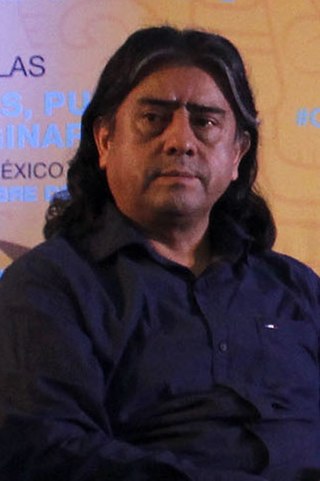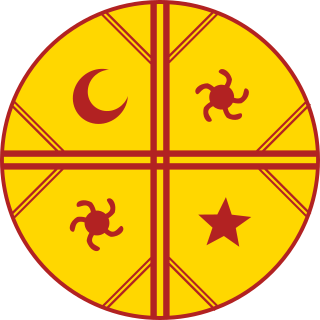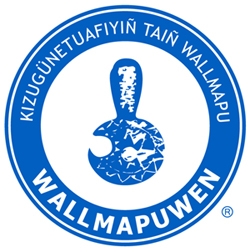
Mapuche or Mapudungun is an Araucanian language related to Huilliche spoken in south-central Chile and west-central Argentina by the Mapuche people. It was formerly known as Araucanian, the name given to the Mapuche by the Spaniards; the Mapuche avoid it as a remnant of Spanish colonialism.

The Mapuche also known as Araucanians are a group of indigenous inhabitants of south-central Chile and southwestern Argentina, including parts of Patagonia. The collective term refers to a wide-ranging ethnicity composed of various groups who share a common social, religious, and economic structure, as well as a common linguistic heritage as Mapudungun speakers. Their homelands once extended from Choapa Valley to the Chiloé Archipelago and later spread eastward to Puelmapu, a land comprising part of the Argentine pampa and Patagonia. Today the collective group makes up over 80% of the indigenous peoples in Chile and about 9% of the total Chilean population. The Mapuche are concentrated in the Araucanía region. Many have migrated from rural areas to the cities of Santiago and Buenos Aires for economic opportunities, more than 92% of the Mapuches are from Chile.

The Araucanía, La Araucanía Region is one of Chile's 16 first-order administrative divisions, and comprises two provinces: Malleco in the north and Cautín in the south. Its capital and largest city is Temuco; other important cities include Angol and Villarrica.

Aucán Huilcamán Paillama is the leader ("werkén") of the indigenist Mapuche organization Consejo de Todas las Tierras. He intended to run for president in the 2005 election, but his candidacy was not accepted as he was not able to collect enough official votes validated by public notaries.

The Arauco War was a long-running conflict between colonial Spaniards and the Mapuche people, mostly fought in the Araucanía region of Chile. The conflict began at first as a reaction to the Spanish conquerors attempting to establish cities and force Mapuches into servitude. It subsequently evolved over time into phases comprising drawn-out sieges, slave-hunting expeditions, pillaging raids, punitive expeditions, and renewed Spanish attempts to secure lost territories. Abduction of women and war rape was common on both sides.
Kalku or Calcu, in Mapuche mythology, is a sorcerer or witch who works with black magic and negative powers or forces. The essentially benevolent shamans are more often referred to as machi, to avoid confusion with the malevolent kalku. Its origins are in Mapuche tradition.

Mapuche religion is the traditional Native American religion of the Mapuche people. It is practiced primarily in south-central Chile and southwest Argentina. The tradition has no formal leadership or organizational structure and displays much internal variation.

The Occupation of Araucanía or Pacification of Araucanía (1861–1883) was a series of military campaigns, agreements and penetrations by the Chilean army and settlers into Mapuche territory which led to the incorporation of Araucanía into Chilean national territory. Pacification of Araucanía was the expression used by the Chilean authorities for this process. The conflict was concurrent with Argentine campaigns against the Mapuche (1878–1885) and Chile's wars with Spain (1865–1866) and with Peru and Bolivia (1879–1883).

Indigenous peoples in Chile or Native Chileans form about 13% of the total population of Chile. According to the 2017 census, almost 2,200,000 people declare having indigenous origins. Most Chileans are of partially indigenous descent; however, indigenous identification and its legal ramifications are typically reserved to those who self-identify with and are accepted within one or more indigenous groups.

Wallmapuwen is a Mapuche political organization trying to establish itself as a political party in the Chilean legal system. Its political ideology is generally based on leftism, democracy, Mapuche nationalism, self-determination and secular government.

The Mapuche conflict involves indigenous Mapuche communities, historically known as the Araucanians, located in Araucanía and nearby regions of Chile and Argentina.
The last major rebellion of the indigenous Mapuches of Araucanía took place in 1881, during the last phase of the Occupation of Araucanía (1861–1883) by the Chilean state. It was planned by Mapuche chiefs in March 1881 to be launched in November the same year. Mapuche support for the uprising was not unanimous: Some Mapuche factions sided with the Chileans and others declared themselves neutral. The organizers of the uprising did however succeed in involving Mapuche factions that had not previously been at war with Chile. With most of the attacks repelled within a matters of days Chile went on the next years to consolidate its conquests.

A ruka or ruca is a traditional Mapuche house type. Rukas were originally round with a conical roof. Rucas are typically built communally. Rukas traditionally lack windows and are made up a single open space in the interior. The interior of the rukas are organized around a central fireplace.
As an archaeological culture, the Mapuche people of southern Chile and Argentina have a long history which dates back to 600–500 BC. The Mapuche society underwent great transformations after Spanish contact in the mid–16th century. These changes included the adoption of Old World crops and animals and the onset of a rich Spanish–Mapuche trade in La Frontera and Valdivia. Despite these contacts Mapuche were never completely subjugated by the Spanish Empire. Between the 18th and 19th century Mapuche culture and people spread eastwards into the Pampas and the Patagonian plains. This vast new territory allowed Mapuche groups to control a substantial part of the salt and cattle trade in the Southern Cone.
The origin of the Mapuche has been a matter of research for over a century. The genetics of the Mapuche do not show overly clear affinities with any other known indigenous group in the Americas, and the same goes for linguistics, where the Mapuche language is considered a language isolate. Archaeological evidence shows Mapuche culture has existed in Chile at least since 600 to 500 BC. Mapuches are late arrivals in their southernmost and easternmost (Pampas) areas of settlement, yet Mapuche history in the north towards Atacama Desert may be older than historic settlement suggest. The Mapuche has received significant influence from Pre-Incan (Tiwanaku?), Incan and Spanish peoples, but deep origins of the Mapuche predates these contacts. Contact and conflict with the Spanish Empire are thought by scholars such as Tom Dillehay and José Bengoa to have had a profound impact on the shaping of the Mapuche ethnicity.

Juana Calfunao Paillaléf is one of the main authorities or chiefs (Lonko) of the Mapuche indigenous community of south-central Chile. She is the chief of the Juan Paillalef community, of Cunco, Araucanía Region.
The Mapuche uprising of 1766 was the last major Spanish–Mapuche conflict in Araucanía.

The Mapuche football team is a football team representing the Mapuche of Chile and Argentina and is controlled by the Mapuche Football Association, founded in 2007. The stated mission of the team is "...to allow Mapuche as a distinct cultural entity, with common interests to be represented at the international level in the sport. Mapuche is a member of ConIFA and COSANFF. Mapuche would have participated in the 2020 ConIFA World Football Cup.

The Council of All Lands or Aukiñ Wallmapu Ngulam (AWNg) is an indigenist separatist organization that defines itself as aimed to create a "Mapuche state" in Chile and Argentina in the territories defined as "Wallmapu" by them. Its leader is the "werkén" Aucán Huilcamán. The organization has its roots in the Commission for the 500 years of resistance, created in 1989 as a splinter group of ADMAPU, whose members had become critical of ADMAPU. The commission subsequently changed name to Consejo de Todas las Tierras in 1990.

Wallmapu is the word in the Mapuche language to say "Universe" or "set of surrounding lands", currently used by some historians to describe the historical territory inhabited by the Mapuche people of southern South America. The term was coined in the early 1990s by Indigenist groups but gained traction in the 2000s as the Mapuche conflict in Araucanía intensified. Some view the Wallmapu as being composed of two main parts Ngulumapu in the west and Puelmapu in the east, with the southern part of Ngulumapu being known as Futahuillimapu.













